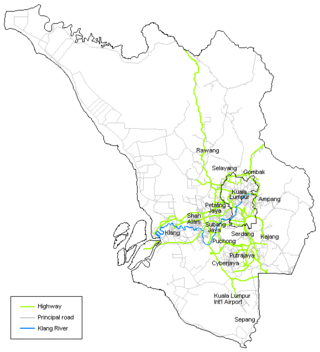Top Qs
Timeline
Chat
Perspective
Klang Valley
Urban conglomeration in Malaysia From Wikipedia, the free encyclopedia
Remove ads

Klang Valley (Malay: Lembah Klang) is an urban agglomeration in Malaysia centred on the federal territories of Kuala Lumpur and Putrajaya, along with their surrounding cities and towns in the state of Selangor. It is part of the larger Greater Kuala Lumpur metropolitan area.
The Klang Valley is geographically defined by the Titiwangsa Mountains to the east and the Strait of Malacca to the west. It stretches to Rawang in the northwest, Semenyih in the southeast and Klang and Port Klang in the southwest.[1] The conurbation forms the core of Malaysia's industrial and commercial activity.[2] As of 2022, the Klang Valley is home to around 9 million people, nearly one third of Malaysia's total population of 32 million.[3]
Remove ads
Origin
The valley is named after the Klang River, the principal river that flows through it that starts at Klang Gates Quartz Ridge in Gombak and flows into the Straits of Malacca in Port Klang, The river is closely linked to the early development of the area as a cluster of tin mining towns in the late 19th century. Development of the region took place largely in the East-West direction (between Gombak and Port Klang) but the urban areas surrounding Kuala Lumpur have since grown north and south towards the border with Perak and Negeri Sembilan respectively.
Remove ads
Regions
There is no official designation of the boundaries that make up the Klang Valley but it is often assumed to comprise the following areas and their corresponding local authorities:

Core Constituencies in the Klang Valley (Greater Kuala Lumpur)
Constituencies in the Greater Klang Valley (including the Rawang and Langat River Valley)
Sometimes included (for TV and radio broadcasting)
Course of the Klang River is shown in blue.
- Federal Territory of Putrajaya
- Federal Territory of Kuala Lumpur
- Selangor district of Petaling
- Selangor district of Klang
- Selangor district of Gombak
- Selangor district of Hulu Langat
- Selangor district of Sepang
- Selangor district of Kuala Langat
Remove ads
Transport
Summarize
Perspective
Although the Klang Valley officially consists of separate cities and suburbs, integration between these areas is very high, supported by a developed road network and an expanding integrated rail transit system. Many expressways criss-cross the metropolis, making cars the most convenient way to travel. However, this has resulted in the Klang Valley's notorious traffic jams and extremely car-centric infrastructure, making peak hour driving exhausting and time consuming. Since the 1990s, several new rail systems such as Rapid KL's light rapid transit (LRT), mass rapid transit (MRT), KTM Komuter, ERL's airport rail links and the monorail have been developed, with most undergoing extensive expansions. The Klang Valley Integrated Transit System is currently being upgraded to include a new MRT line, the LRT line and a proposed monorail to serve Putrajaya.
Despite these developments, public transport in the Klang Valley still suffers from serious shortcomings. Although bus networks across the region are extensive, last mile connectivity remains poor and many rail stations are located in isolated areas. As a result, ridership on these systems remains low, with many residents still preferring to drive.[4] In 2024, National Defence University of Malaysia associate professor Wu Chai Bin stated that traffic congestion in the Klang Valley might persist for more than a decade unless the public transport network is fundamentally reimagined.[5][6]
See also
References
Wikiwand - on
Seamless Wikipedia browsing. On steroids.
Remove ads
